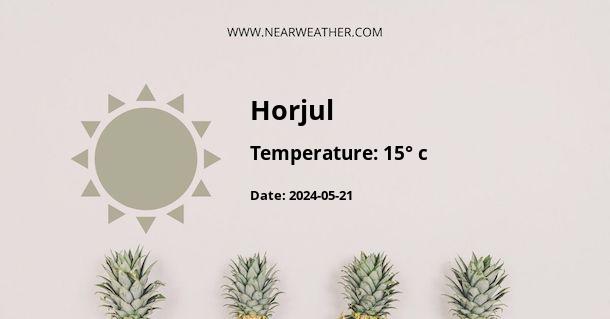Horjul, Slovenia: A Comprehensive Climate and Weather Guide
Horjul is a charming municipality in the Inner Carniola region of Slovenia, known for its picturesque landscape and historically rich culture. Understanding the climate and weather patterns of Horjul can be beneficial for locals, tourists, and enthusiasts who seek to explore this serene Slovenian gem. In this comprehensive guide, we delve into various meteorological aspects of Horjul, providing an in-depth look at the weather you can expect year-round.
Geographical Context of Horjul
Horjul’s geographical positioning significantly influences its climate. Situated at an approximate altitude of 350 meters above sea level, the area experiences a Continental climate with characteristics moderated by the proximity to the Adriatic Sea to the southwest and the Alps to the north.
Temperature Overview
The temperatures in Horjul vary considerably with the changing seasons. The warmest month is typically July, with an average high of 26°C (78.8°F), while the coldest month is January, experiencing average lows of -2°C (28.4°F).
Seasonal Climate Breakdown
- Spring (March to May): This season is marked by a gradual rise in temperatures and increased precipitation. Springtime in Horjul sees the landscape come to life with blooming flora. March tends to start off cool, with conditions warming up significantly by May.
- Summer (June to August): Summers are generally warm and pleasant, with the occasional heatwave pushing temperatures above 30°C (86°F). Rainfall is relatively frequent in the form of thunderstorms, resulting from the warm, moist air rising and condensing. This season is the best time for outdoor activities in and around Horjul.
- Autumn (September to November): Autumn brings about a noticeable drop in temperatures and daylight hours. This period can be quite wet, with October often being the rainiest month. The landscape is characterized by stunning autumnal colors, making it a great time for photography and sightseeing.
- Winter (December to February): Winter in Horjul is cold, with snowfall common, particularly in January and February. Despite the chilly temperatures, the snow-covered scenery provides an idyllic backdrop for winter sports and cozy retreats.
Precipitation Patterns
Horjul's annual precipitation averages around 1400 mm (55.1 inches). The rain is spread throughout the year, although the summer months see the highest rainfall due to convective precipitation. Snowfall is typical in the winter months and provides a crucial source of water for the area as it melts into the spring.
"Horjul's climate is representative of the diverse weather patterns found in Slovenia, from warm summers to snowy winters." - Slovenian Meteorological Society
Climate Tables for Horjul
| Month | Average High (°C) | Average Low (°C) | Average Precipitation (mm) |
|---|---|---|---|
| January | 2 | -2 | 65 |
| February | 5 | -1 | 60 |
| March | 10 | 1 | 70 |
| April | 15 | 6 | 95 |
| May | 20 | 10 | 110 |
| June | 23 | 13 | 130 |
| July | 26 | 15 | 120 |
| August | 26 | 15 | 120 |
| September | 21 | 11 | 140 |
| October | 15 | 7 | 150 |
| November | 9 | 3 | 120 |
| December | 3 | 0 | 80 |
Note that this table provides average values, and actual conditions can and do vary. Local microclimate conditions can also affect weather patterns significantly.
Wind and Air Quality
The wind in Horjul is generally mild throughout the year but can pick up during the passage of cold fronts. Air quality in the region is typically good, thanks to the rural setting and low levels of industrial activity. However, during winter, temperature inversions can trap pollutants leading to episodes of poorer air quality, especially in valley areas.
Extreme Weather Events
While Horjul is not prone to extreme weather such as tornadoes or hurricanes, it can occasionally experience severe thunderstorms and hail during the summer months. The area is also susceptible to heavy snowfall in winter, which can disrupt transportation and power supply.
Climate Change Considerations
Horjul, like many other parts of the world, is subject to the impacts of climate change. Changes include shifts in precipitation patterns, more frequent heatwaves, and milder winters. Such effects can challenge local agriculture, water resources, and biodiversity. Commitment to sustainability and adaptation strategies is essential for the region's resilience.
Conclusion
Horjul's climate is a critical component of its regional identity, affecting its natural landscape, local lifestyles, and economic activities. With distinct seasons ranging from warm summers to snowy winters, Horjul offers a dynamic climate that caters to a variety of preferences and activities throughout the year. Whether you're looking to embrace the snowy wonderland of winter, the blossoming beauty of spring, the warm embrace of summer, or the crisp air and colorful foliage of autumn, Horjul's climate is an integral part of what makes this Slovenian locale a special place to visit or call home.
A - Horjul's Latitude is 46.023609 & Longitude is 14.299170.
A - Weather in Horjul is 12° today.
A - Climate Conditions in Horjul shows overcast clouds today.
A - Humidity in Horjul is 75% today.
A - Wind speed in Horjul is 2.77 km/h, flowing at 257° wind direction. today.
